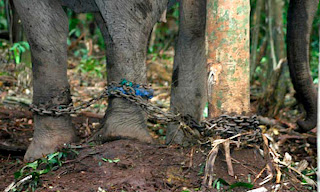
Forest elephants tend to be smaller and darker with tusks that are straight and point downward in contrast to the tusks of a savanna elephant which curve upward. In addition to the difference in tusks, both savanna and forest subspecies have differences the sizes and shapes of the skull and skeleton. It is estimated that one third to one quarter of elephants are forest elephants. Asian elephants are smaller than African elephants consisting of four subspecies: Borneo Pygmy, Sri Lankan, Sumantran and Indian. Asian elephants are an icon to Asian culture. Indian mythology says that elephants are one of the nine jewels that surfaced as the gods searched for an elixir for immortality.
The Borneo Pygmy elephants are the smallest of the animals and possibly the cutest, with the gentlest nature of all the Asian elephants. They have straight tusks, baby faces, over-sized ears, plump bellies and long tails that drag behind them. They were once believed to be the remnants of Sultan Sulu's domesticated heard but WWF has determined them genetically different from their Asian counterparts.
Sri Lankan elephants are the largest and darkest of the Asian elephants, yet they have patches of no skin tone on their bodies. The Sri Lankan population has drastically dropped 65% since the turn of the 19th century and for this reason these elephants are protected by Sir Lankan law and killing one results in the death penalty.

Sumatran elephants tend to have smaller tusks but despite this fact they are still targets of poachers. This poaching specifically hurts the Asian population even more because only males have tusks. The main danger to elephants besides poaching is the conflicts that occur with humans, especially retaliation kills after an elephants destroys crops or perhaps kills a human.
Elephants have are matriarical herds lead by the oldest female. The only time a bull comes in contact with a herd is during mating. The rest of the year a bull lives in isolation. A mother carries her calve for twenty-two months, longer than any other mammal. A female usually has a calf once every four to five years. Because of the attachment to the heard it is known that a calf will stay by it's mother's dead body sometimes dying itself. This obviously is one of the many qualities of elephants similar to human emotions. Elephants have a distinct call almost like a deep grumble that is audible only to other elephants. When there is a cull, a killing of herd, an elephant can use this call to warn elephants miles away not to come in that direction. There are hundreds of reasons to protect these magnificent animals. There is no reason to kill any animals whether it be elephants for ivory or rhinos for medicine. (668 rhinos died in 2010, a 50% increase, for their medicinal use in villages in Asian.) To find out more about elephants and to help keep all animals free from chains go to: http://worldwildlife.org and Wildlife Crime Story
"The questions is, are we happy to suppose that our grandchildren may never be able to see an elephant except in a picture book?" David Attenborough




No comments:
Post a Comment